Authors:
Laura J. Perovich, Ilya Vidrin, Nicole Zizzi
The importance of data in society—and its volume—has increased drastically over the past few decades. Data plays a central role in our infrastructures, health systems, and knowledge production processes. It is also increasingly tied up in civic life and used to make decisions about matters that affect us all, from economic to environmental to social issues.
As data becomes even more pervasive in our daily lives, it is important to examine how it is represented and the impact those modes of representation have. Over the past decade, data physicalization research has provided an alternative to data visualization within HCI by building on ideas in tangible interfaces and centuries of artistic, sculptural, and object-based representations of information. By providing alternative ways of representing data, many data physicalization researchers aim to ensure that diverse communities can access the social power data is entwined with.
→ Data physicalization starts from an object-centered understanding of embodiment.
→ Researchers in data embodiment, data somatics, and somadata are designing new ways to represent data that start from a felt, bodily understanding of embodiment.
→ Researchers should consider what we mean by embodiment and the implications.
The embodied nature of data physicalizations is often touted as a key benefit that facilitates different types of learning, engagement, and access. Yet, there is little discussion on what data physicalization researchers mean by embodiment and what this implies about the possible benefits of this approach. Who or what is doing the embodying? What level of nuance and complexity does that embodiment afford? What senses are centered and what kinds of embodied experiences do they bring about? What other approaches to embodiment are possible?
In this article, we take a closer look at ideas of embodiment in data physicalization. We also identify other methods that diversify the ecosystem of data representation and serve as a generative grounding for bodily approaches to embodiment in data representation. In our decades of experience in embodied research and creative practice, we have noticed how challenging it can be to center body-based embodied experience in HCI and how worthwhile those efforts can be. We hope this article will evoke a closer consideration of embodiment and inspire more design work on bodily data representations.
Embodiment is both an enduring long-term area of research work and a timely topic. Western philosophers and religious thinkers, from Descartes to Dewey, have been writing about embodiment and the nature of humans and human bodies for hundreds of years, building on an even longer Eastern history of inquiry about embodiment. Much of this work explores the relationship between the body and the mind—whether they are separable or a unified whole. Throughout this process, scholars and practitioners have investigated the conditions necessary for an embodied experience: (How) does embodied experience include the body? What does it center?
These divisions and questions echo within the history of HCI and design—from Mark Weiser's 1991 foundational work contrasting ubiquitous computing and virtual reality through his stances on embodiment [1] to Paul Marshall and colleagues' 2013 remarks on divergent understandings of embodied interaction [2] to Sarah Homewood et al.'s 2021 review of the plurality perspectives on the body in HCI [3]. Embodiment is currently a central topic in many HCI subfields beyond data physicalization, including soma design, virtual reality, and social robotics, among others. All these areas understand embodiment differently: from soma design's richly nuanced, integrated, and human understanding of embodiment to virtual reality's work that uses simple sensory experiences to give a person the impression that they are embodying a digital avatar.
Movement-based approaches to data representation may allow people to more fully access the benefits of embodied cognition on learning, as the design process and outcomes intentionally engage the body.
In this article, we explore one concrete example of how different understandings of embodiment can lead to diverging design outcomes and processes within a subfield. Surfacing these implications in the context of data physicalization reveals the stakes around embodiment and why researchers should carefully examine and clarify the nature of embodiment in their work.
 An Ecosystem of Novel Data Representations
An Ecosystem of Novel Data Representations
Data physicalization is one of the most prominent novel approaches to representing data in the HCI community. As "physical artefact[s] whose geometry or material properties encode data" [4] they are thought to afford an embodiment that is beneficial to people's understanding, learning, and sensemaking around data, and to facilitate social and emotional engagement with important information.
There is ambiguity, however, in the literature around what is "embodied" in data physicalization. Many papers refer to how data is "embodied" in the physical object in data physicalization—a view that doesn't require a person. This approach to embodiment draws on early work on tangible user interfaces and ubiquitous computing that proposed "embodied user interfaces" are physical objects with a "body" that is integrated with the device's content, intent, and purpose [5]. Notably, in this framing, embodied and body refer to the material nature of the artifact itself; human bodies and their sensory experiences, movements, and interactions are not the core concern.
The implications of this understanding of embodiment are also evident in a prominent data physicalization gallery (http://dataphys.org/list/gallery/), where a majority of the artifacts are visibly legible. The physicalizations often take similar forms as traditional visualizations (e.g., 3D printed bar charts and knitted heatmaps) and don't require bodily interaction or the kinetic, proprioceptive, and touch-based sensory experiences those interactions would afford. The images chosen for the gallery include few people, again suggesting that the embodiment primarily "happens" in the object itself, not in a felt human experience (Figure 1).
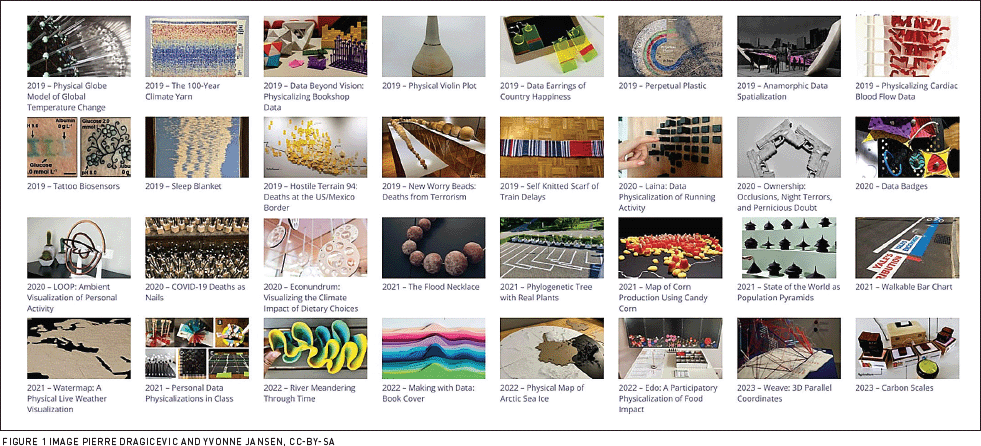 | Figure 1. Objects, not human bodies, are the focus in the lead images in a prominent data physicalization gallery, in alignment with the subfield's understanding of embodiment. |
This raises two key questions about embodiment in data representation: What do we mean by embodiment, and what role does it play? For data physicalization, embodiment is largely a means for information to take physical and tangible form in an object, with or without any further explicit human interaction.
But other approaches to embodiment in data representation are emerging (Figure 2). Narrative physicalization, data embodiment, somadata, and data somatics, among others, take a bodily and felt perspective on embodiment that centers the bodily human experience while representing data. The role of embodiment varies in these data practices (Figures 3 and 4). Some approaches, such as data embodiment and somadata, emphasize embodiment in the process of creating the data representation, but may center visual or auditory sensory experiences in the data representation. Other approaches, such as data somatics and narrative physicalization, bring more focus to bodily experience in the data representations, either with (narrative physicalization) or without (data somatics) physical objects that facilitate those experiences. Approaches such as somadata represent data as it is generated with the bodies and environments creating it, while the other approaches largely draw on previously collected data that may or may not connect closely to the people experiencing it or the situations from which it originates. Each approach also draws inspiration from different embodied practices, including theater (data embodiment), dance (data embodiment, data somatics), and somatics (data somatics, somadata).
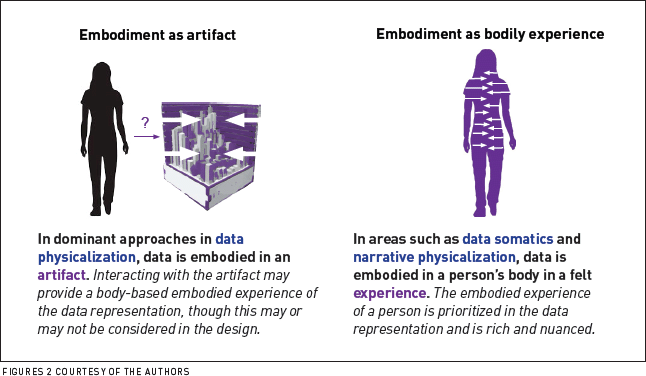 | Figure 2. Emerging research areas explore a more bodily perspective on embodiment that stands in contrast to the object-centered perspectives on embodied dominant in data physicalization research. |
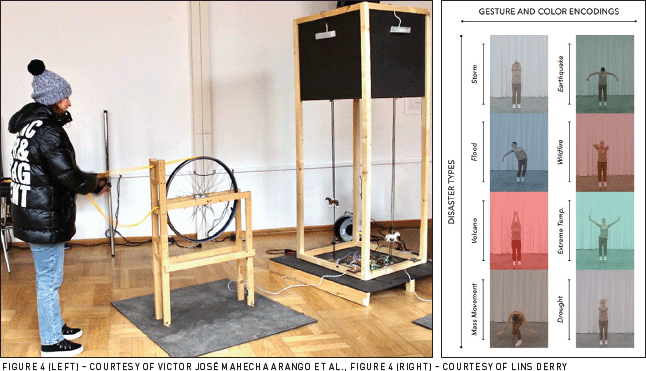 | Figure 4. The narrative sensification A Fair Game? (left) [6] conveys passport power through physical exertion. The data embodiment Data Sensorium (right) [7] is a performance of data created through a bodily process. |
Our work in data somatics has shown us that this bodily approach to embodiment in data representation is promising. In our workshop series [8] (Figure 5), dancers designed movement sequences intended to provide people with a bodily experience of online open source data. Their representations did not include objects or visually oriented approaches. Instead, the dancers designed movement instructions (e.g., "raise your arm while taking three steps to the right" and "you're running to catch the bus") that the "audience" would follow to create a data representation that was physically experienced.
Movement-based approaches to data representation may allow people to more fully access the benefits of embodied cognition on learning, as the design process and outcomes intentionally engage the body, instead of assuming that meaningful bodily interaction will emerge if a physical object is provided. These bodily experiences of data can surface questions related to the situated or emotional experiences that become masked by traditional approaches to data. For example, many dancers became interested in possible changes in people's economic, mental health, or living conditions that might be affecting—or be affected by—the alcohol sales data on which our data representations were based. This aligns with feminist critiques of dominant data practices and observations by data embodiment researchers on the potential benefits of the "somatic processing" of data.
Instead of only saying embodiment or embodied, researchers should describe the nature of that embodiment so that the implications of what is on offer are clear.
Approaches to embodiment that are bodily, social, and shared can also create space for critical conversations about data. In our workshops, we saw dancers collectively making sense of data, despite their different levels of experience. Throughout their movement-based explorations, they discussed the overall meaning of the data, outliers, and comparisons between datasets. They also asked questions about methodological choices such as normalization and the impact of local laws on data collection and reliability.
Data somatics and other bodily and felt approaches to embodiment in data representation are exciting new approaches in the data representation ecosystem. Building on the "somatic turn" in HCI, they create space to design for people's bodies and their holistic, affective, and kinesthetic embodied experiences, instead of focusing on objects as material "bodies" that perform embodiment by acting as a container for information.
It is important to bring attention to these related efforts and to continue to find ways to elevate the bodily aspects of embodiment in information design research and in HCI more broadly. Providing a rich idea of embodiment can enhance tactile, haptic, multisensory, and immersive approaches to data representation that are becoming more common in the literature. These approaches can also help us look beyond the artifact-centered mentality that is still dominant in much of HCI and data visualization research.
These divergent understandings of embodiment in data physicalization are one example of a larger phenomenon: Researchers often mean very different things when they use the word embodiment, both within a given field or subfield and across disciplines.
If past is prologue, it is unlikely that researchers—in data physicalization or more broadly—will agree on one shared definition of embodiment to move forward with. But it is important to consider the polysemous nature of the concept and to do more to clarify our position when using this term. Instead of only saying embodiment or embodied, researchers should describe the nature of that embodiment so that the implications of what is on offer are clear.
The stakes around embodiment are high. The somatic understanding of embodiment that centers the sensations, feelings, thoughts, and movements we experience in the world in relation to ourselves and others is central to our existence and tied to our ability to thrive. Understandings of embodiment that background humans or rely on a limited sensory palette (e.g., vibration-focused approaches in VR) may provide alternative benefits, but also risk flattening our expectations of what embodied experience can and should be. These questions, concerns, and considerations will continue to become more pressing as artificial intelligence and other technologies push us to define the bounds of humanness.
Over the past several years, researchers have developed a variety of novel data representation approaches that use different means, media, and modalities to engage communities with data, facilitate learning, and promote critical thought.
Within HCI, much of this work has been centered on data physicalization. In this article, we draw attention to a complementary emerging set of approaches that take a richer understanding of embodiment in data representation. By moving the focus from "embodying" data in artifacts to "embodying" data through felt, somatic, and movement-based bodily experiences of people, these approaches provide new opportunities and the possibility of more fully realizing the potential benefits of embodiment.
Our discussion is one example of the hidden impacts of diverging understandings of embodiment. As a research community, we should always ask what we mean by embodiment—and what that means for the artifacts we design, the expectations we have about that experience, the kinds of benefits our work brings, the research we do, and what it means to be human.
1. Weiser, M. The computer for the 21st century. Scientific American 265, 3 (1991), 94–105.
2. Marshall, P., Antle, A., Van Den Hoven, E., and Rogers, Y. Introduction to the special issue on the theory and practice of embodied interaction in HCI and interaction design. ACM Transactions on Computer-Human Interaction 20, 1 (2013), Article 1, 1–3.
3. Homewood, S., Hedemyr, M., Fagerberg Ranten, M., and Kozel, S. Tracing conceptions of the body in HCI: From user to more-than-human. Proc. of the 2021 CHI Conference on Human Factors in Computing Systems. ACM, 2021, Article 258, 1–12.
4. Jansen, Y. et al. Opportunities and challenges for data physicalization. Proc. of the 33rd Annual ACM Conference on Human Factors in Computing Systems. ACM, 2015, 3227–3236.
5. Fishkin, K.P., Gujar, A., Harrison, B.L., Moran, T.P., and Want, R. Embodied user interfaces for really direct manipulation. Communications of the ACM 43, 9 (2000), 74–80.
6. Mahecha Arango, V.J., Ovais, M., Youssef, Y., Das, S., Van Koningsbruggen, R., and Hornecker, E. 'A fair game?': Using narrative sensification and embodied metaphors for awareness. Proc. of the Eighteenth International Conference on Tangible, Embedded, and Embodied Interaction. ACM, 2024, Article 27, 1–12.
7. Derry, L. Data embodiment: Approaching the body as a choreographic medium for performing abstract data. International Journal of Performance Arts and Digital Media 19, 1 (2023), 1–23.
8. Perovich, L.J. and Zizzi, N. Feeling data through movement: Designing somatic data experiences with dancers. Proc of the Eighteenth International Conference on Tangible, Embedded, and Embodied Interaction. ACM, 2024, Article 23, 1–11.
Laura J. Perovich is an assistant professor in the Art + Design department at Northeastern University. Her current work focuses on novel data representation strategies, embodied design practices, and the ways that people experience information in the world. [email protected]
Ilya Vidrin is an assistant professor of creative practice research at Northeastern University. His work draws on value sensitive design, which he has applied most recently in creative residencies at the Harvard ArtLab, MIT Media Lab, Temporal Communities Cluster (Berlin], National Choreographic Center (Akron, Ohio], and the New Museum (New York]. [email protected]
Nicole Zizzi is an interdisciplinary artist, creative movement practitioner, lecturer, and researcher at Northeastern University's College of Arts, Media and Design. She is also artistic director of Evolve Dynamicz, a Boston-based mixed-ability dance company whose work fosters an appreciation for physical and mental diversity. [email protected]
 This work is licensed under Creative Commons Attribution-Sharealike International 4.0.
This work is licensed under Creative Commons Attribution-Sharealike International 4.0.
The Digital Library is published by the Association for Computing Machinery. Copyright © 2025 ACM, Inc.
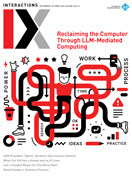

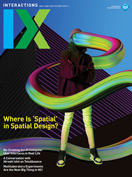

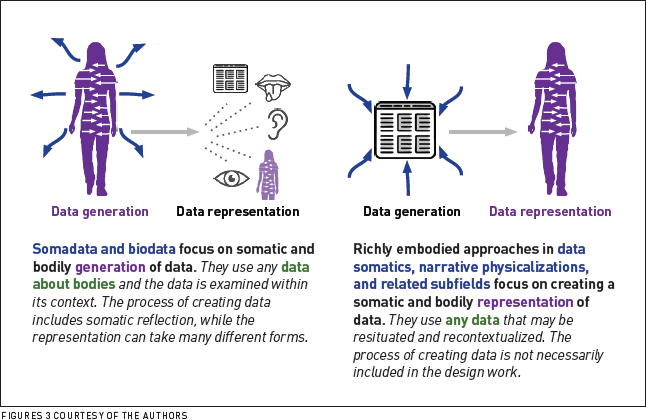
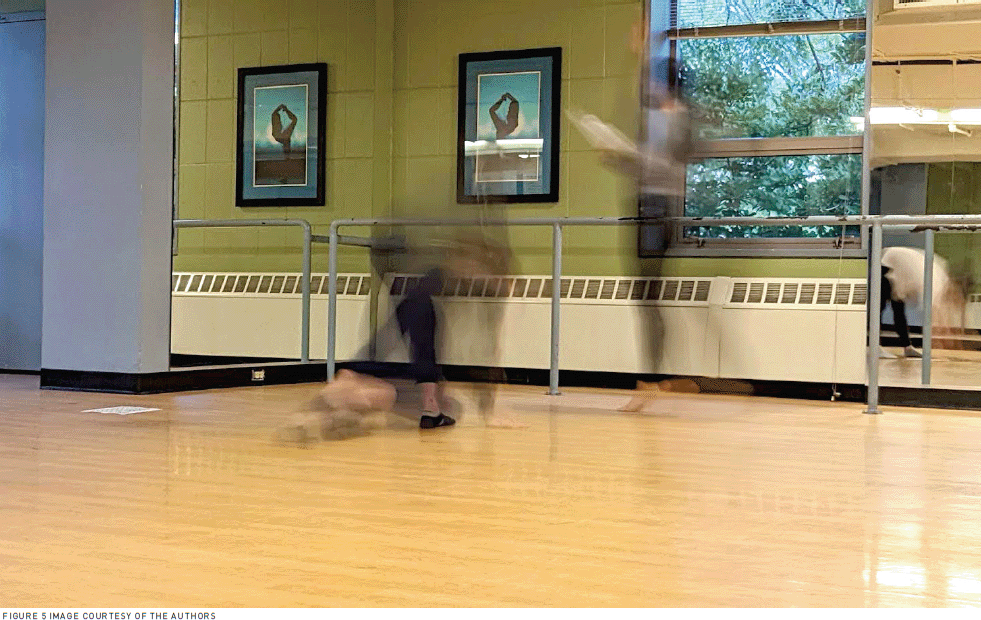



Post Comment
No Comments Found